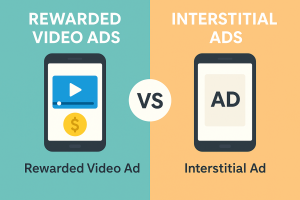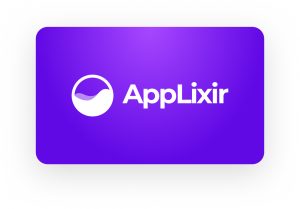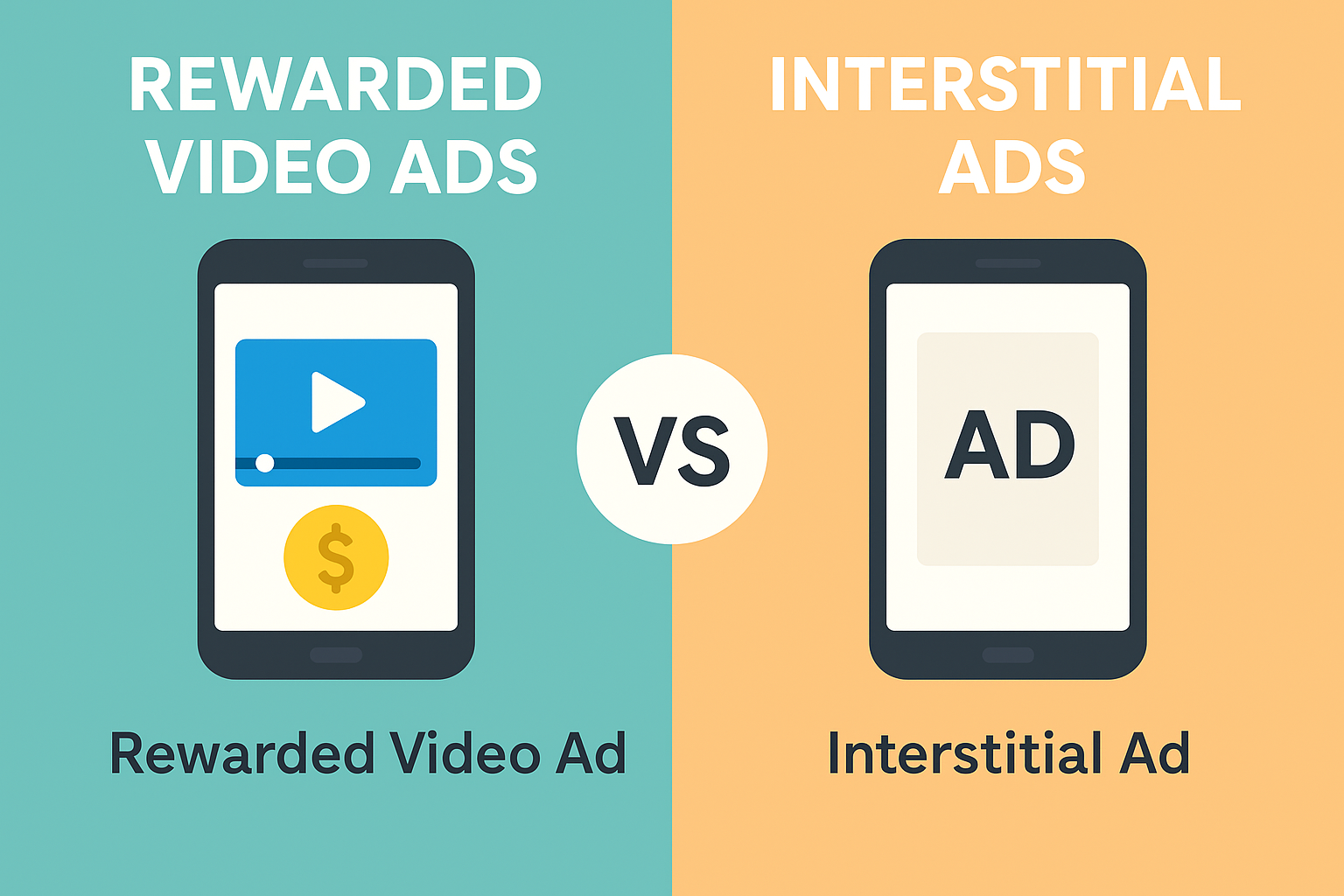Rewarded Video Ads vs. Interstitial Ads: The Difference Explained
What’s the Difference and Which Should You Use? Rewarded Video Ads vs. Interstitial Ads? In-game advertising has become the backbone of mobile game monetization, generating billions in revenue annually while keeping games free-to-play for millions of users worldwide. As developers navigate the competitive landscape of app monetization, understanding the nuances of different ad formats can mean the difference between a thriving game and one that struggles to retain players.
Two ad formats dominate the mobile game monetization space: Rewarded Video Ads and Interstitial Ads. While both serve the fundamental purpose of generating revenue, they take dramatically different approaches to user engagement and experience. Rewarded video ads offer players something valuable in exchange for their attention, while interstitial ads capture eyeballs during natural breaks in gameplay.
The choice between these formats—or the decision to use both—directly impacts not just your revenue, but also player retention, session length, and overall game satisfaction. In this comprehensive guide, we’ll break down everything you need to know about rewarded video ads and interstitial ads, compare their strengths and weaknesses, and help you determine which format (or combination) will maximize your game’s monetization potential while keeping players happy and engaged.
Contents
- 1 What Are Rewarded Video Ads?
- 2 What Are Interstitial Ads
- 3 Rewarded Video Ads vs. Interstitial Ads – Key Differences
- 4 Which Ad Format Is Better for Monetization?
- 5 User Experience and Engagement Impact
- 6 When to Use Rewarded Video vs Interstitial Ads
- 7 Final Thoughts: Balancing Ad Strategy for Maximum ROI
What Are Rewarded Video Ads?
Rewarded video ads are user-initiated, opt-in advertisements that provide players with tangible in-game benefits in exchange for watching a video. Unlike forced advertising, these ads put control in the player’s hands—they choose when and whether to engage with the advertisement based on their current needs in the game.
The mechanics are straightforward: a player encounters a prompt offering a reward for watching a video ad. If they accept, they view a 15-30 second video (typically non-skippable to ensure advertiser value), and upon completion, they receive their promised reward. Common rewards include:
- In-game currency (coins, gems, tokens)
- Extra lives or continues to keep playing after failure
- Power-ups or boosts that enhance gameplay
- Level skips for particularly challenging stages
- Unlockable content such as characters, skins, or areas
- Time accelerators in idle or farming games
Rewarded video ads have become ubiquitous across gaming platforms, appearing in mobile games on iOS and Android, Unity games, HTML5 games, and WebGL games. Their versatility makes them equally effective in puzzle games, action titles, strategy games, and casual mobile experiences. The format works because it creates a value exchange that feels fair to players—they’re giving their time and attention voluntarily, not having it demanded of them.
From a technical standpoint, implementing rewarded video ads for web games and mobile applications has become increasingly streamlined, with major platforms like Unity Ads, Google AdMob, and IronSource offering easy integration through SDKs. Unity rewarded ads, in particular, have become a standard feature for developers using the Unity engine, with built-in support that requires minimal coding expertise.
What Are Interstitial Ads
Interstitial ads are full-screen advertisements that appear at natural transition points or breaks in gameplay. Unlike their rewarded counterparts, interstitial ads are non-voluntary—they’re triggered by the game’s logic rather than player choice, appearing when the system determines it’s an appropriate moment to show an advertisement.
These ads typically display during moments such as:
- Level completion screens
- Game over sequences
- Menu transitions
- Loading screens
- Between rounds or matches
- App launch (though this is less common and more disruptive)
Interstitial ads come in several formats: static image ads, video ads (which may be skippable after 5-10 seconds), or interactive rich media ads that invite user engagement. The mandatory nature of interstitials means they guarantee impressions, making them attractive from a pure visibility standpoint—every player who reaches a trigger point will see the ad.
However, this guarantee comes with trade-offs. Because players don’t choose to view interstitials, the format can feel intrusive if not implemented thoughtfully. Poorly timed interstitials—such as those appearing mid-action or too frequently—can frustrate players and lead to app abandonment. The key to successful interstitial implementation lies in placement: showing ads at moments when players expect a natural pause, such as after completing a level or when they’ve chosen to restart after failure.
In terms of app monetization strategy, interstitials excel at generating high impression volumes, particularly in games with short, repetitive sessions. Casual games, hyper-casual titles, and arcade-style games with frequent natural breaks are ideal candidates for this ad format.
Rewarded Video Ads vs. Interstitial Ads – Key Differences
Understanding the core differences between these two formats is essential for building an effective monetization strategy. Here’s a comprehensive side-by-side comparison:
| Feature | Rewarded Video Ads | Interstitial Ads |
|---|---|---|
| User Control | Opt-in, completely voluntary | Non-optional, system-initiated |
| Reward | Yes—coins, lives, power-ups, etc. | No in-game benefit |
| User Experience | Generally positive; player feels valued | Can be disruptive if poorly timed |
| Ad Completion Rate | High (70-90%+) | Moderate (varies with skip option) |
| eCPM | Higher ($10-50+ depending on geo/game) | Lower ($2-15 average) |
| Placement Timing | Player-initiated at points of need | System-triggered at transitions |
| Impact on Retention | Positive or neutral | Can be negative if overused |
| Best Use Case | Monetizing engaged players who want benefits | Maximizing impressions and reach |
| Skip Rate | Very low (players chose to watch) | Higher (when skip option available) |
| Player Sentiment | Appreciated as helpful feature | Tolerated at best, resented at worst |
The most striking difference is psychological: rewarded video ads create a positive exchange where players feel they’re getting value, while interstitials are purely extractive from the player’s perspective. This fundamental difference cascades into all other metrics.
Rewarded video ads typically command higher eCPM (effective cost per thousand impressions) because advertisers value the engaged attention of users who voluntarily watch ads. Completion rates soar when players have skin in the game—literally waiting for their reward. Meanwhile, interstitials may generate more total impressions due to their mandatory nature, but each impression is typically worth less and carries higher risk of player frustration.
Which Ad Format Is Better for Monetization?
The question of which format generates better revenue doesn’t have a simple answer—it depends on your game’s design, player base, and monetization goals. However, data from the industry reveals clear patterns.
Rewarded video ads typically drive superior long-term monetization for several compelling reasons. First, their higher completion rates (often exceeding 85%) combined with premium eCPM rates mean each ad impression generates more revenue. A rewarded video ad might earn $20-40 eCPM in tier-1 markets (US, Canada, UK, Australia), while interstitials often hover in the $5-12 range.
More importantly, rewarded videos contribute to better player retention and increased ARPDAU (Average Revenue Per Daily Active User). When players can overcome challenges or accelerate progress through rewarded ads, they stay engaged longer, play more sessions, and paradoxically become more likely to make in-app purchases. The value proposition of rewarded ads doesn’t cannibalize IAP—it complements it by keeping players invested in the game.
Interstitial ads excel in specific scenarios: games with very short session lengths (under 2 minutes), hyper-casual titles where players expect quick restarts, and games with frequent natural transition points. For these games, the sheer volume of interstitial impressions can outweigh the lower per-impression value. A hypercasual game might show 5-10 interstitials per session versus 0-2 rewarded ads, potentially generating higher total revenue despite lower CPM.
The most sophisticated monetization strategies employ both formats strategically:
- Use rewarded ads as the primary monetization tool for engaged players
- Implement interstitials sparingly at high-traffic moments (level complete, session end)
- Cap interstitial frequency (e.g., maximum once every 3-5 minutes or 2-3 levels)
- A/B test different combinations to find your optimal mix
- Segment users based on engagement—show more interstitials to casual players, more rewarded options to engaged players
Game monetization strategies that balance both formats typically see 20-40% higher overall ad revenue compared to single-format approaches, while maintaining better retention metrics.
User Experience and Engagement Impact
Beyond pure revenue numbers, the impact of ad formats on user experience fundamentally shapes your game’s success. Player retention, session length, and word-of-mouth growth all hinge on how respectfully you implement advertising.
Rewarded video ads build positive brand associations between your game, your ad partners, and the player. When a player uses a rewarded ad to gain an extra life and successfully complete a challenging level, they associate that positive outcome with the ad experience. Studies show that players exposed to well-implemented rewarded ads rate games higher, play longer sessions, and show increased willingness to recommend the game to others.
The opt-in nature creates psychological ownership—players feel they’re making strategic decisions about when to use ads as tools. This transforms advertising from an annoyance into a game mechanic. Some games brilliantly integrate rewarded ads into their core loops: idle games offering time skips, roguelikes providing revives, and puzzle games granting hint coins.
Interstitial ads, conversely, risk session drop-off when poorly implemented. Industry data shows that aggressive interstitial frequency correlates strongly with user churn. Show an interstitial every level in a casual puzzle game, and you might see 15-25% of players abandon the game within their first session. The frustration compounds when ads appear at unexpected moments or too frequently.
However, thoughtful interstitial placement minimizes negative impact:
- After voluntary actions (player chooses to restart level)
- At natural endpoints (completing a level, finishing a round)
- With frequency capping (showing at most 1 per 2-3 levels or 5 minutes)
- With smooth transitions (brief loading screens before ad)
The critical insight for app retention is that ad frequency matters more than format. Even rewarded ads become tiresome if prompts appear too aggressively. The sweet spot involves offering rewarded opportunities 3-5 times per session, showing interstitials 0-2 times per session, and ensuring at least 2-3 minutes between any ad types.
Video monetization platforms now provide sophisticated tools for managing ad frequency, pacing, and user segmentation, allowing developers to optimize for the delicate balance between mobile game advertising revenue and user satisfaction.
When to Use Rewarded Video vs Interstitial Ads
Strategic placement of ad formats requires understanding your game’s structure, pacing, and player psychology. Here’s how to determine which format fits different scenarios:
Use Rewarded Video Ads When:
Integrating with Core Mechanics
- Offering continues or extra lives in action/arcade games
- Providing hint coins or skip options in puzzle games
- Granting time acceleration in idle or farming games
- Unlocking premium features temporarily (ad-unlocked power-up)
- Doubling rewards after level completion
Example: In an endless runner, place a rewarded ad offer at the game-over screen: “Watch video to continue with your power-ups?” This feels natural because the player is already invested in their run and wants to extend it.
Monetizing Engaged Players
- When players demonstrate high session frequency (daily players)
- At moments of high player intent (close to completing challenge)
- When players need just a little help to progress
For Unity Monetization and Unity Games Unity’s built-in ad mediation makes rewarded video implementation straightforward. Place rewarded ads at:
- Skill tree unlock points
- Crafting or upgrade stations
- Between waves in tower defense games
- As optional challenge rewards
Use Interstitial Ads When:
Maximizing Impressions at Natural Breaks
- After every 3-5 completed levels
- On return to main menu
- After game over (if no rewarded ad shown)
- Between rounds in multiplayer matches
- After tutorial completion
Example: In a match-3 puzzle game, show an interstitial after every third completed level, during the transition back to the level map. This feels less intrusive than mid-gameplay interruption.
In High-Session-Volume Games Hyper-casual games with 30-second sessions can sustain more frequent interstitials because:
- Sessions are disposable (low emotional investment per round)
- Players expect quick resets
- High session frequency creates many natural break points
To Monetize HTML5 Games and WebGL Games For browser-based games where players may not return frequently, interstitials ensure monetization from casual, one-time visitors while rewarded ads capture value from engaged players who return multiple times.
Genre-Specific Considerations:
- Puzzle Games: Heavy rewarded (hints, level skips) + occasional interstitials (every 3-4 levels)
- Action/Arcade Games: Primary rewarded (continues, power-ups) + rare interstitials (session end)
- Idle/Incremental Games: Almost exclusively rewarded (time skips, resource boosts)
- Casual/Hyper-Casual: Balanced mix or interstitial-heavy (short sessions support frequency)
- Strategy/RPG Games: Primarily rewarded (resource packs, gacha spins) integrated into game systems
The overarching principle: meet players where they are emotionally. When they’re invested and want to progress, offer rewarded ads. When they’re naturally disengaging (level complete, returning to menu), interstitials feel less intrusive.
Final Thoughts: Balancing Ad Strategy for Maximum ROI
There’s no universal formula for perfect ad monetization—every game has unique pacing, player psychology, and revenue goals. However, successful developers share common approaches to balancing monetization and user experience.
Start with player experience as your north star. The most lucrative monetization strategy means nothing if players abandon your game after a few sessions. Build your ad implementation around moments that feel natural and fair. Test aggressively using A/B testing frameworks to understand how different frequencies, placements, and combinations affect both revenue and retention.
Use data to drive decisions. Implement analytics that track:
- Ad impressions and completion rates by format
- Revenue per user segmented by engagement level
- Session length before and after ad exposure
- Day-1, day-7, and day-30 retention correlated with ad experience
- ARPDAU broken down by ad format contribution
Consider an ad revenue calculator to model different scenarios before implementation. These tools help you understand trade-offs: showing one more interstitial per session might increase revenue by 15% but decrease retention by 8%—is that worthwhile for your game’s lifecycle strategy?
The hybrid approach typically wins: games that thoughtfully combine rewarded video ads (as the primary, player-friendly format) with carefully placed interstitials (at genuine break points, with strict frequency caps) consistently outperform single-format strategies. The rewarded ads drive engagement and ARPDAU while interstitials capture additional impressions from natural transitions.
Platform-specific optimization matters too. Unity monetization tools, for example, offer built-in mediation that automatically optimizes which ad networks to call for maximum eCPM. For developers working to monetize HTML5 games or monetize Unity game projects, leveraging these platforms’ sophisticated targeting and optimization can boost revenue by 20-40% compared to direct integrations.
Remember that monetization models for games continue evolving. Stay informed about mobile app monetization strategies, test new formats as they emerge (like playable ads or rewarded interstitials), and always keep measuring the balance between short-term revenue and long-term player value.
Ultimately, the best ad strategy is one that feels invisible to players who embrace it and unobtrusive to those who don’t. When players willingly engage with your rewarded ads because they’re genuinely helpful, and barely notice your strategically placed interstitials, you’ve achieved monetization mastery—sustainable revenue that grows alongside a loyal, satisfied player base.
Looking to implement rewarded video ads or interstitial ads in your game? Start by mapping your game’s natural break points and player pain points, then test different combinations with real users. The data will guide you to your optimal monetization balance.

